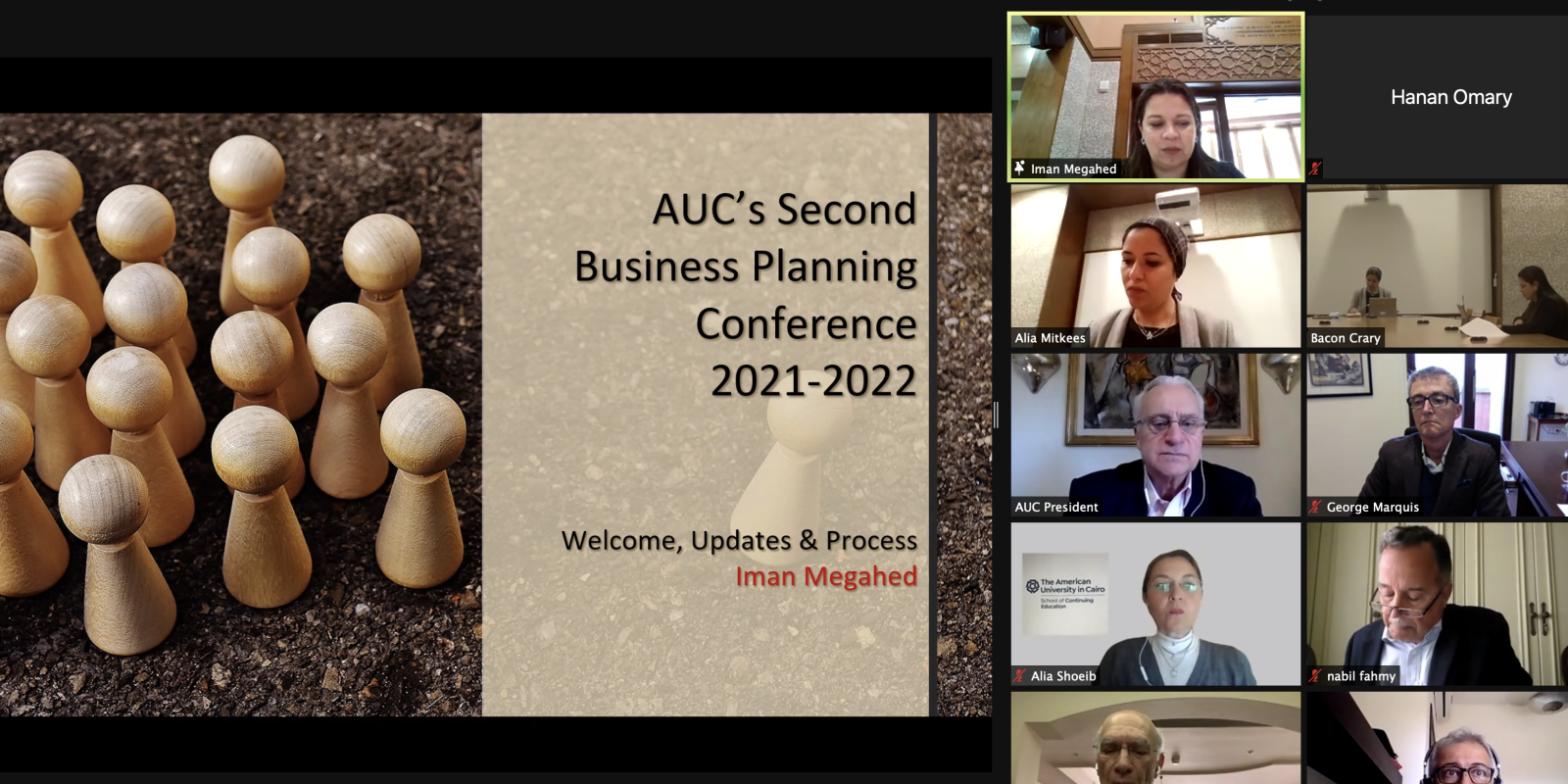
The Future of AUC: Second Annual Strategic Business Planning Conference
Strengthening its culture of community involvement, AUC held the Second Annual Strategic Business Planning Conference this week, virtually bringing together around 70 AUC leaders to discuss the University’s FY22 plans and the integrated planning process at large.
“Plans to inform budget” was a common message iterated during the two-day conference, highlighting AUC’s commitment to planning as the means to align, optimize resources and inform its budget. As Provost Ehab Abdel-Rahman said quoting the Board of Trustees, "The planning should lead the budget," not the other way around.
Despite the ongoing global situation, AUC is keen on remaining ahead of the curve in terms of re-internationalization of the student body, sustainability, excellence, quality of education and research. High emphasis was placed on catering to research requirements not only of the present but also the future.
President Francis Ricciardone praised the AUC community's unprecedented "persistence, diligence and commitment" to excellence despite the obstacles we faced. He emphasized the need to form a common mental map of AUC’s direction moving forward, stressing that priorities are what inform budgets and not the other way around.
“A constant key throughout our planning as we look at those three big priorities of internationalization, sustainability of management and excellence of our performance [is to ensure those] translate to customer service,” President Ricciardone said.
Looking ahead, the conference stirred up conversations around AUC’s new strategic plan and the need to adopt a participatory yet target-oriented approach to building on the University’s accomplishments. Participants discussed the “future of AUC” in terms of new trends, future employment opportunities and student demands based on market needs in an ever-changing world.
The discussions set the layout for academic plans and preliminary resources to be communicated to academic schools, deans and support units. Administrative priorities, plans and directions were examined, detailing the major initiatives and projects that different AUC areas are planning to implement, challenges they’re currently facing and enhancements they wish to bring about.
The integrated planning process aims to identify and coordinate priorities across AUC while exploring the required resources to bring them to fruition. Every year, the planning cycle commences with a kickoff meeting that closes the loop on the previous cycle and paves the way for the new one — serving as a venue for leaders to identify collaboration points, synergies and redundancies in a collegial forum.
“The need to define our direction clearly will allow us to prioritize our efforts and resources in an agile manner, as we continue to adjust to this new normal where change has become the only constant,” said Iman Megahed, associate vice president for digital transformation. “Both the pandemic and our heightened competition have made this evident.”
What Participants Say
“The SMIE summit is one of the main highlights of my seven-month tenure at AUC. It was an opportunity to hear about how to expand and make AUC thrive as the international destination it is in a highly competitive local and global market. It is the first summit or conference of its kind that I have attended in my decades-long academic career, which makes me proud to be an AUCian in the soon-to-be post-COVID times. I am looking forward to working with all at AUC in making our collective strategic plans thrive.”
— Daniel Ortiz, dean, Libraries and Learning Technologies
“As the name implies, this conference is only the second in what is intended to be an annual planning cycle going forward. The conference is an opportunity to drive an integrated planning cycle across the entire University and to align the different annual plans with each other. It determines our priorities as an institution for the coming year, which in turn informs the prioritization of resources in the form of our budget allocations and our human resources planning. This planning exercise is important enough under normal circumstances, but with the additional constrains that COVID-19 has put on us, as it has with all organizations, it makes this planning cycle all the more critical to both our short term as well as our long-term success.”
— Ayman Abdellatif, senior vice president for planning, administration and transformation
“Through these University-wide meetings, we can identify our priorities, break down the silo mentality and pave the way for developing a unified vision of the future of academic programs at AUC. When we look at emerging degree programs or the top degrees in demand for the future, we notice they are often cross-disciplinary and difficult to classify within a certain discipline. If we continue to discuss academic programs in silos within departments, we will continue to see growth in programs as well as programs that are struggling with low enrollment, and we will be missing out on emerging trends that can create opportunities for AUC. There is a rapid pace of change in the environment, students are looking for value and relevance, the competition is fierce, and the financial pressures are severe — and we need to undertake the appropriate changes to stay ahead of the competition before it is too late.”
— Zeinab Amin, associate provost for assessment and accreditation; professor, Department of Mathematics and Actuarial Science
